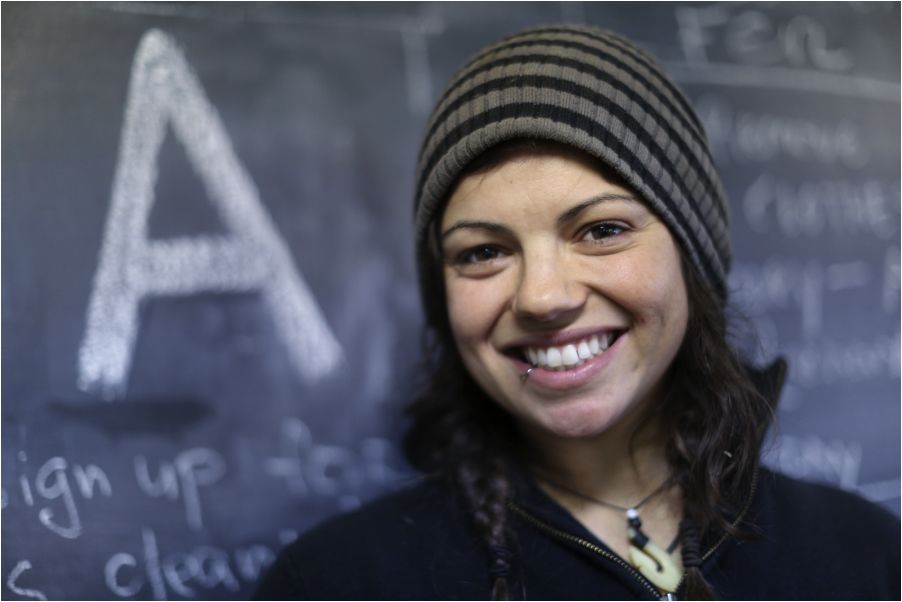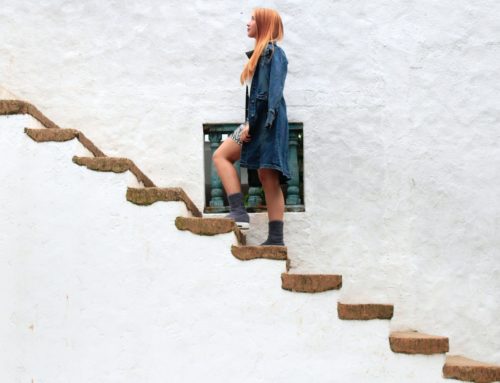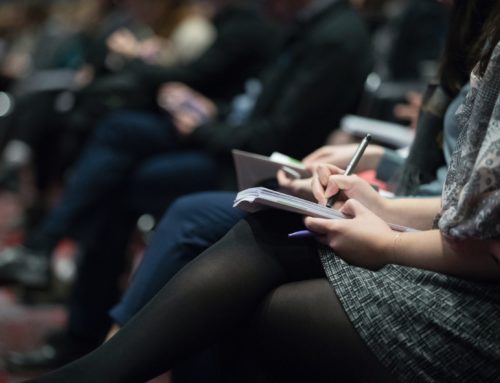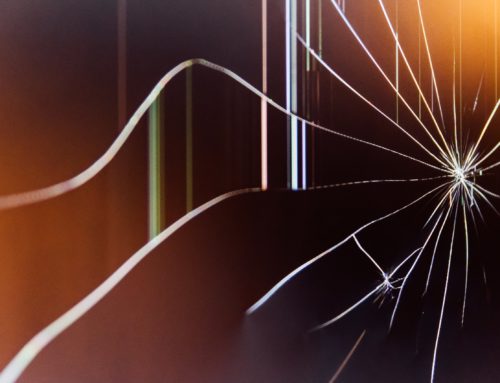By Sally Morton
Georgia Hirsty is an activist and the Warehouse Director for Greenpeace International based out of Oakland, California. I first heard her speak at the Commonwealth Club for a panel organized by ClimateOne titled “Fighting Fossils Fuels all the Way to Prison” with activist Tim DeChristopher. Georgia has worked as an activist in different capacities since college. Last July she was involved in the St. John’s Bridge Action against Shell drilling in the Arctic. She believes in the solidarity of all social justice issues and believes that women are just as capable of directing a ship in the high seas as men are!
Sally Morton: Starting off with a little bit of your background, where you’re from, if you went to school, how you got involved with Green Peace?
Georgia Hirsty: I grew up outside of Fort Wing, Indiana, and moved to California when I was 18. At the time I was politically involved around the anti war movements; race, class and gender was my particular focus. I moved across the country, went to a small Quaker school in Los Angeles, named Whittier, where Richard Nixon went. I was politically active in school, working with race, class and gender. I worked against sweatshops.
When Katrina happened, I was watching the news on my way to a political science conference, seeing how overtly racist the coverage was and the interplay between racism and environmental catastrophes. Two of my colleagues and I went to New Orleans—I was working for a free speech radio program, and trying to get more of the real story out. New Orleans kind of fundamentally changed my perspective, well not fundamentally, but really made me see how these forms of oppression interact with one another. So after that, I spent a number of weeks initially doing interviews with folks, and spent a lot of time over the course of a few years working with people and volunteering for different organizations that were filling the spaces that needed to be filled there.
So that’s how I first got involved with environmental activism and environmental justice. I studied political science in college, with an emphasis in social movements. Then I heard about Greenpeace, found out about it doing a research project about the globalization of media and what that means for global activist movements. The women and black movement really stood out to me. Also Greenpeace specifically stood out to me as a program that utilized the principles of nonviolence and independence, and did not take any support from corporations or governments so that they could stay true to their idea of protecting the environment. I got involved shortly after I graduated and have been involved in various capacities over the past eight years.
SM: Do you have any specific examples, short anecdotes, from your time in New Orleans?
GH: There were a lot of different lessons I learned in New Orleans, some were very positive and others were really important and very sad. So one of the major lessons I learned was how easy it is to victimize those that are suffering and how destructive that really is. That difference between intention and impact when you have this rush of volunteers coming to this area to help people. But really they were victimizing the same people that had intended to help. They were taking their agency away. So you had these hordes of people going and gutting houses because that’s what they believed was the right thing to do but the locals were not involved in that decision making process. You know there’s that famous quote: “If you’ve come here to help me then you can go home but if you’ve come here because your liberation is bound up with mine, then let’s work together.” So that became really evident, through the organizing that I saw there, that difference between what it means to just drop into a community and make your own decision vs deferring to the impacted communities, and the locals. Those were important lessons.
There were a lot of people, initially after the storm, folks who were being forced to leave against their will. The ninth ward hadn’t been drained yet and wouldn’t be for about a month, there was still water in the seventh ward, even though the French quarter, which was at a lower elevation, was totally dry. So I was, you know, at just nineteen or 20 years old, interviewing these locals who were protesting by refusing to leave. A lot of them had survived Hurricane Betsy, so they had set up these roof camps, and were totally dependent on one another to take care of each other. Through all of their struggle and perseverance, and the horrible situation that was the response to that disaster, finding ways to be joyful with each other and still love, I think probably, more than anything, is the biggest lesson I learned. I walked away from that learning, as much as you are in the struggle, you have to find those moments of joy and love with each other, and be the real definition of being the change you wish to see in the world. This is something that has to be present in the way that we organize, how communities organize, and the way that we interact with each other. They were actively fighting all of those other issues in those moments. You know if you’re fighting for an environmental issue, you still have to represent all of the other forms of oppression, racism, sexism, homophobia. So in that way I’m very grateful to all of those folks who let me into their community and also taught me some pretty important lessons as a twenty year old.
SM: Thank you. In Greenpeace, what sort of jobs have you undertaken?
GH: Well, I’ve had a lot of different positions with Greenpeace. My first job was as a street fundraiser. Which was really interesting… you know… it was terrible. Fundraising on the street is terrible. But it allowed me to interact with people in a way that I hadn’t before, and the idea of raising money for a cause rather than a product is a really interesting thing. Then I ran a canvas office in Seattle for a short period of time. It was really interesting to experience, as the director of a canvas office, what drew people to Greenpeace, what motivated people. Both in a good way, where people would come and be completely inspired and just want to do something and not know where they fit into the movement, but then also the flip side. I saw a lot of activism focused on that kind of hyper individualism, where people would come and say, “Well I want to work for Greenpeace because I want to save the world.” And so that also really impacted me, you know feeding off of what I learned at Katrina, wanting to organize in a way, as in a community, rather than an ego driven movement.
And then I worked in a warehouse very similar to this one on a contract sweeping floors, fixing boats and things. Greenpeace has three ships that police the high seas, and do a lot of different projects. So I worked as a sailor on one of the Greenpeace ships for five years. That was three months on the ship, three months off. In my off time I worked with organizations and did other things. The ship was this microcosm of the world we wanted, all different kinds of people from different backgrounds, different ethnicities, different countries, on this 150 foot vessel trying to fight to protect the environment, but also you know, just get along, which was challenging. And we went to the most beautiful places I’ve ever seen and we went to the saddest place I’ve ever seen. It was interesting to get a global perspective on environmental justice and what an environmental organization at a global level looked like from the top decision makers to the deck hands on one of their vessels. I learned a lot there.
Then a couple years ago I took a position managing this warehouse, then last year I took over the entire warehouse program. We have two big warehouses and a number of national fleet, and equipment that travels between warehouses and other communities. It’s a very interesting organization in one of the ways that I work on the Greenpeace actions team. I have a base responsibility of managing all of the equipment in the warehouses. We are really focused on turning the warehouses into community spaces and distributing as much of the resources as we can—in terms of things but also in terms of training, meeting spaces and skills. We also work on a project basis. So when there’s an action or an event that needs to be coordinated, we also do that within the framework of our team.
SM: You spoke at the panel on Fossil Fuels hosted by Climate One, about being suspended from the bridge in Portland, radioing with the Fennica, Shell’s Oil tanker about to drill in the Arctic. How did you end up being in that position?
GH: There are so many different roles that I have in my life, and that we all have in our lives. I do the work that I do fundamentally because I’m an activist. Often I find myself in either a coordinating role or a manger role, but at the end of the day, you know, I’m an activist. So particularly for the action on the St. Johns Bridge, there was a really short time line and a specific skill set. There’s never a point where someone is told they have to do something, especially when there are legal consequences. So people stepped up who were willing and able to do the activity based on a series of variables: the short time line and being able to take legal risk, which is also a privilege and influences who can do what and how. So yeah I just kind of ended up being the one. The group of people who ended up going was mostly people I’ve been working with for the past ten years. Not just in Greenpeace and environmental work but also locally with local battles that expand the horizon of issues. That was one of the most beautiful things about the St. Johns Bridge action, you know really understanding the lens of environmental justice and how people come to it and whether that’s because they have an affinity for dolphins or the amounts of pollution they have in their communities is devastating for their families, or indigenous rights, or blatant racism—all of those things are impacted by climate change and what’s happening to the environment. So the group of people that it ended up being was really beautiful and interesting. Also it was people who I’ve organized with for the last decade, so you know, I was hanging there with a bunch of my friends.
SM: So I’m curious about what challenges you face as an activist, specifically as a woman. Do you have any particular stories?
GH: Yeah that’s a great question. It’s really interesting I think particularly, at least in my experience, the environmental movement, has been undergoing a big change. Well let me take that back—there has been a long-standing environmental justice movement that has incorporated the solidarity of issues. The big greens in Greenpeace hasn’t always been that so you have sort of main stream environmentalism from the 70s like, Edward Abby, which is super misogynistic, dude bros, ego driven, and funded by white affluent people. That in Greenpeace generally has been shifting pretty dramatically, especially in the last year. A lot of that has been due to of a change in leadership with in Greenpeace, but it has been a constant struggle.
I recognize all of these forms of systemic sexism that I’m being exposed to, but I also don’t want to assimilate as a way of dealing with them. I don’t want to be a jerk, I don’t want to be egotistical, I don’t want to tear up or bring other people down, or be afraid to ask for help—and that gets really difficult in moments. There were a lot of times where I was the only woman on the ship and so any time I drove the crane, or drove a boat, or anything, I had all this focused attention. People were either waiting for me to mess up, or if I didn’t mess up, be totally condescending like, “oh you’re cute and smart.” You know I work in a warehouse and ships are predominately and overwhelmingly, in the maritime industry, worked on by men, and a lot of the times with men from places that have never heard of sexism.
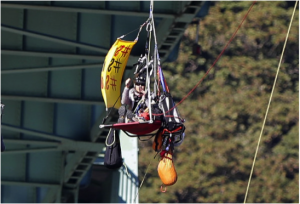
Georgia hanging from the St. John’s Bridge. She was the one to radio with the Fennica, “You are on a collision course with activists, please turn around.” The ship turned around and did not continue on its course. (Portland, OR)
I got into an argument once where I was walking down the stairs of a ship, and I was carrying a five liter bucket and some brooms and things, and a guy on the ship came on the middle of stairs and was trying to wrestle this bucket from me, but it was making me very unstable. So I told him, “Leave me alone, you are causing a dangerous situation right now!”
We got to the bottom of the stairs, and I said to him, “You know I didn’t need help in that moment, I don’t understand why you caused a dangerous situation by insisting that you help me.”
And he very commonly said, “Well you know, that’s just how I was raised, that women shouldn’t carry things because it is going to affect their ability to give birth.”
And I was like, “Ok well, alright.”
You know so I had to try and balance the conversation about why that’s so wrong and also come from a place of love. It’s just so constant at a certain point where it can be a struggle so yeah, that was really hard. I think finding a language to talk about it is really important. You know the culture of violence and rape culture is so prevalent globally where if there are instances of sexual harassment the inclination is still to blame the victim. Even in progressive organizations, and it is so subtle that it is really difficult to put words to. Especially when you’re the only person saying it.
So yes, difficult, but there has been a big change. There was a certain point on the ships when I became the bosun, who is the person in charge of all of the deckhands. I certainty exercised power in that way by making the men clean the toilets and letting the women use the tools. You know, just trying to equalize power and recognize subtle things. For example, when women tend to be more hesitant, and men tend to be more confident, even though they have the exact same skill set. The result then is that the men get opportunities that the women don’t get and that just increases the imbalance of power, because then at a certain point the men do have more experience because they’ve always been differed to because of being overly confident.
Annie Leonard is Greenpeace’s Executive Director—she’s amazing. Greenpeace has been going through this long, and important, and difficult process, as it should be, to really raise up the voices of marginalized communities and people in order to address those same things that are harder to address because they are more nuanced or because they’re more subtle. Both in the opportunities people get, and that extends to race as well, which is a big problem. Well it’s a big problem in the fact that Greenpeace isn’t a diverse enough organization, which comes from those deep engrained forms of racism and sexism. Over the last two years in this warehouse, and the other warehouse, you know we’ve really focused on becoming a community space. All the movements that I’ve been involved in have focused on lifting up the voices of women and people of color and marginalized folks. This has really become a central, organizing principle for us, which has been really great.
SM: What are you focusing on right now?
GH: Well I have a funny job where I have a baseline of responsibilities, which are the warehouses, the warehouse staff, the things that we’re doing, and other things that pop up whenever there’s a campaign need or a project. So you know last, week we were scheduled to build the new tool wall, but instead we needed to paint a giant airship banner. You never really know what’s coming, but the overall focus for the warehouse program on both coasts, and this is really a part of the change that Greenpeace has been going through, has been recognizing that the history of Greenpeace has good things but it also has bad things. And so how do you hold onto the good things and let go of the bad things? And a big part of that is recognizing the responsibility to share resources and so what we’ve been focused on a lot is how to turn our warehouse spaces into community centers where people are empowered, where people can gain skills, where people have agency, not in a way that we’re doing people favors, but that these spaces are spaces that should be shared and figuratively owned. We don’t own this space, but it is collaboratively owned by the community that uses this space and works out of it. So we just hired a new person to take over the east coast warehouse, she just started. So you know, what that looks like over in Maryland. The organizing we do out of this warehouse is very local because it’s Oakland. Land over in Maryland is a very different place. There’s a lot of request over there for national groups that are organizing on a national level. So just figuring out that constant balance of the needs of Greenpeace and the needs of the community, and you know how to really build an inclusive space.
SM: Where do you think right now work in environmental activism needs to be focused on?
GH: It depends upon what perspective you’re coming from. But I think for Greenpeace specifically, and kind of the mainstream movement, that shift to really deferring to impacted communities. Also recognizing how important and necessary the solidarity of issues is and how connected they all are. So to be able to say I’m an environmentalist, also means that I’m against racism, and will fight to end systemic racism, and those two things aren’t opposed. And of course, sexism you know and everything else, that we can all stand strong together. You know what I hear sometimes from people who disagree with that is this idea of “mission drift”. That if we focus on institutionalized sexism or racism, that’s somehow taking away from the work that we’re doing on the environment. I fundamentally disagree with that. We can’t, unless we’re all standing together, we can’t succeed, you know because environmentalism undoubtedly, most impacts those people who are already suffering the most from the institutionalized forms of oppression and violence. So I think more and more that’s happening, and that trajectory needs to continue. To have a narrowed vision in activism, or being a single-issue organization, I just don’t think that that’s the right way forward.
SM: I’m assuming that being an activist is very taxing, and I’m curious how you find balance, or what motivates you when you really just want to quit it?
GH: Yeah that’s a great question and it’s hard to find a balance, especially for me because I work for an activist organization and I’m also an activist. It is very much the orientation of my life. But thankfully it’s not hard in finding a balance in the way of work and personal life because my personal life is so intertwined for all of the activism work I do.
You know to be a member of your community is a form of activism, gardening is a form of activism, to be active in the things you want the world to adopt that will allow for a shifting paradigm, is all activism. Even in my personal relationship at home, if I can’t communicate with my partner and my family under the same principles that I communicate in my activist work, then something is wrong. So that work also needs to be done at home. The question that I think about a lot and that I struggle with in my own life is that so many of these issues are so pressing. There’s certainly beautiful things happening, but you know it’s hard to go a day without hearing about another person being murdered by the police, or another school shooting, or another terrible environmental disaster, or the next thing a corporation is doing to destroy the lives of children. So finding that place for self care, and also how to deal with all the present trauma, also how we heal from historic trauma both as individuals and a community is something certainly that I’m continuing to work on and figure out.
You know there’s a lot of despair when you think about climate change or the history of racism and how to counteract them. It’s also being done on the community level, there’s lots of movements now around, and have been for along time. Becoming more distributed around distributive justice and radical healing and radical honesty and how we make sure we take care of ourselves, whatever that looks like, and also our communities. You know I never want to shut activism off, but how do I make sure I have time for myself to also heal from constantly being surrounded by the devastating natures of the world and fighting for justice? Which I will let you know if I find those answers!
A lot of it for me has been really rooted in make sure I intentionally feed the personal relationships I have and invest in them. I try not to get so absorbed in the big picture of work that I’m not calling my sister on her birthday, or being there when a friend is grieving, because that’s just as radical as anything else I think.
SM: Thank you. To close up, where would you want to see your work in fifty years? What’s your vision? What are you fighting for?
GH: The easy answer to that is freedom and justice. I often think and talk about in different community spaces—what does it look like to win, what does the world look like without racism, without sexism, and without the corporate greed and influence? You know what does that look like? What will we do? On the team we often say that we’re working to work ourselves out of a job so that we won’t need to do this anymore. You know then I would while my days away making furniture and playing guitar and having dinner parties.
While I certainly want, undoubtedly, to win, if winning means that the horrible injustices stop existing. But the thing that drives me isn’t winning, as much as if you can see something that’s going on then there’s no other option to fight to end it. So it doesn’t matter how despairing or unlikely it is, or how much of an uphill slog it is. For me there’s not another way to live, than to be on the right side of the fight for justice. And if that means I shake my fist at someone or the institutions until the day I die then so be it, and if those fights become less because things are healing, then that’s also great.
___________________________________
To listen to Georgia Hirsty at the ClimateOne panel please follow the link:
http://climateone.org/audio/fighting-fossil-fuels-all-way-prison
For more on the Portland, Oregon, protest, visit:
http://www.oregonlive.com/portland/index.ssf/2015/07/greenpeace_rappellers_jumped_o.html

